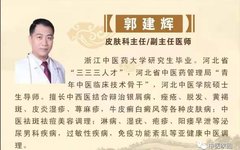The path of Traditional Chinese Medicine (TCM) lies in extensive reading and studying, which allows for better inheritance of its essence and fosters innovation. Reading the classics is the first step and foundation; every TCM practitioner should meticulously study classical texts and apply them in clinical practice to enhance their ability to treat diseases. Let us read the classics daily, making gradual progress, accumulating knowledge over time!
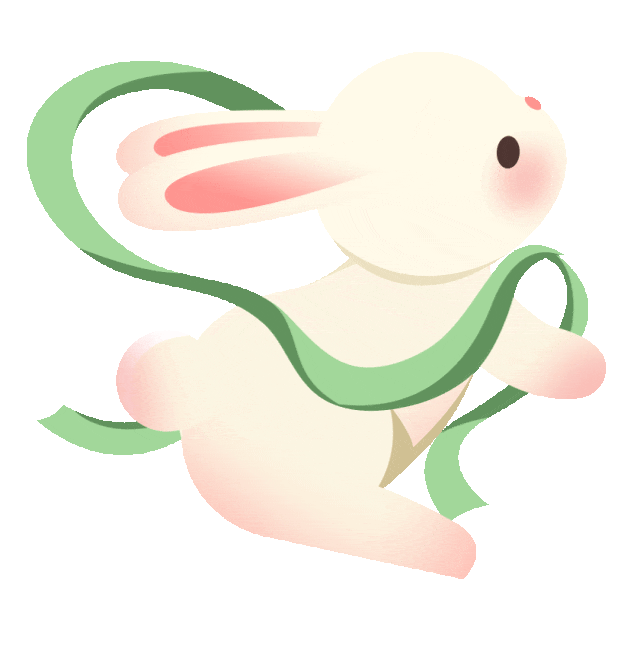
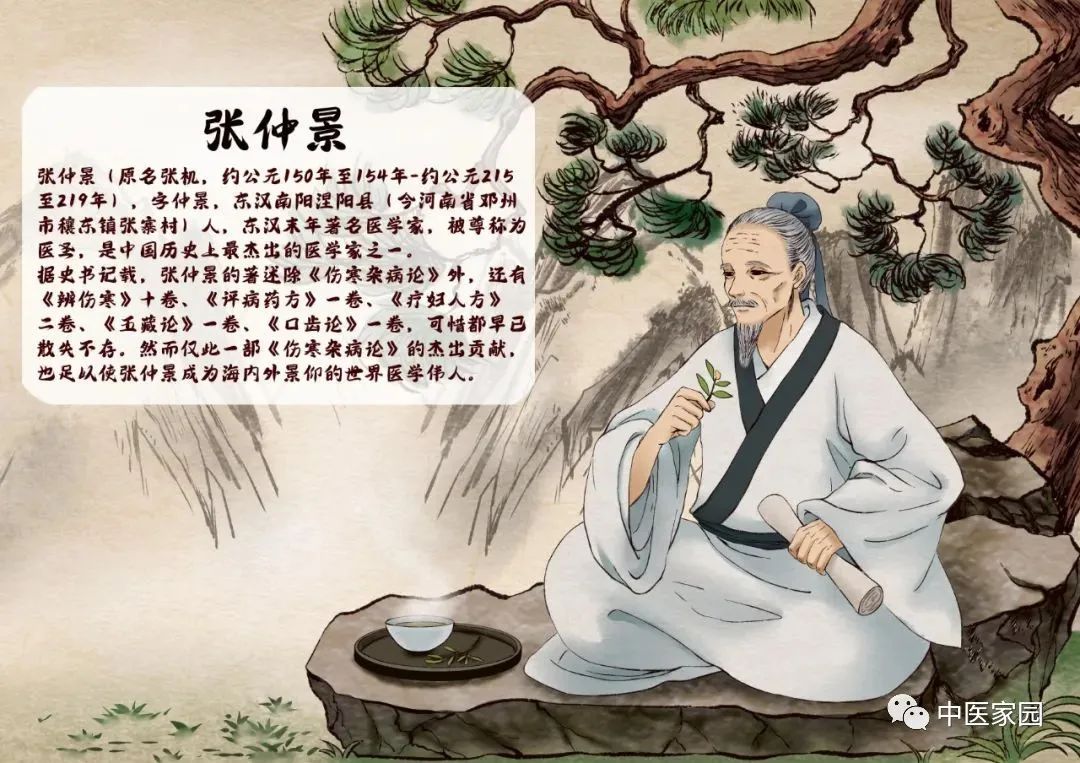
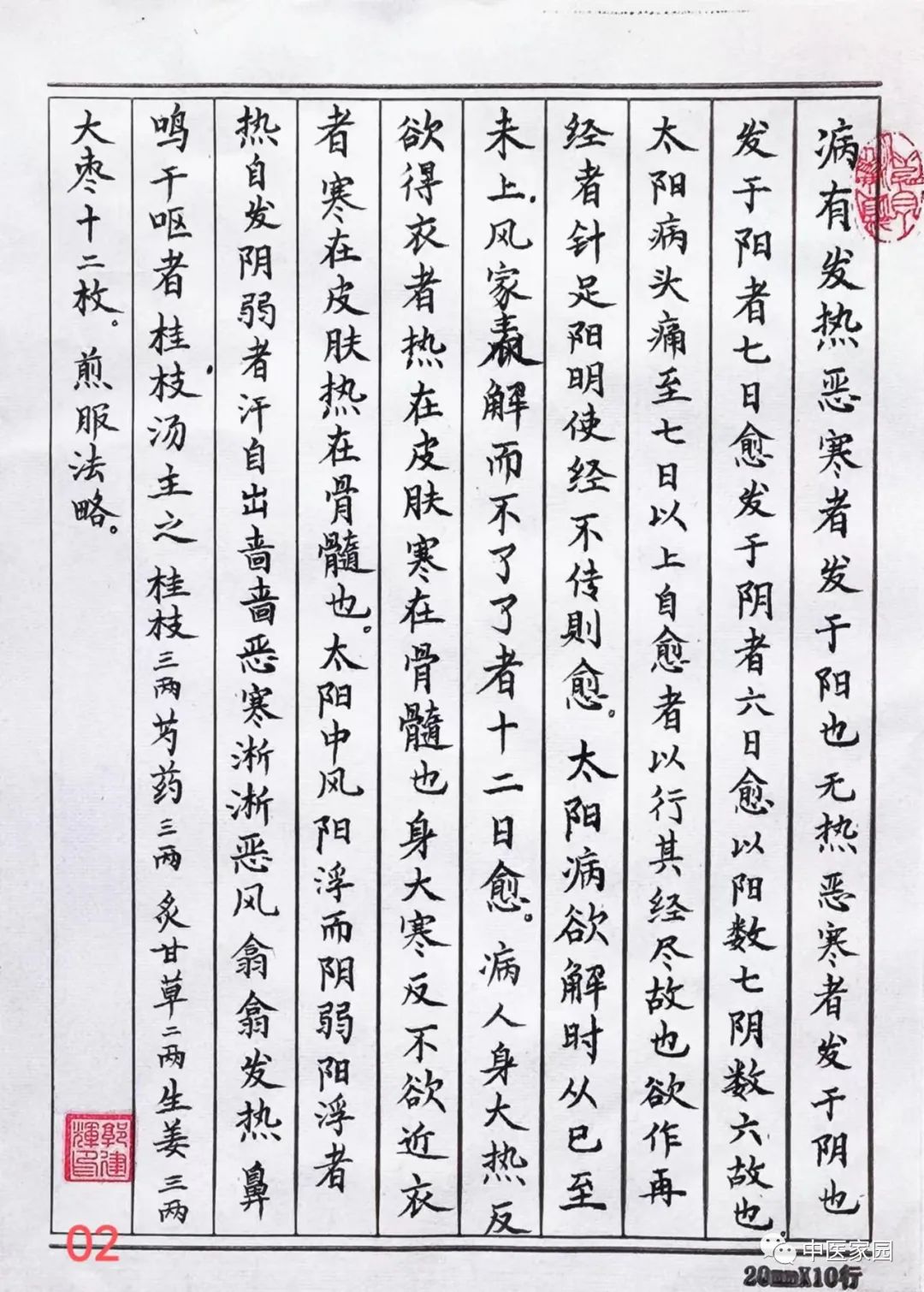
Study Notes on the Treatise on Cold Damage: Original Text Sections 11 and 12.
Identifying and Treating Taiyang Disease (Part 1)
11. If a patient feels excessively hot and desires clothing, the heat is in the skin, and the cold is in the bone marrow; if the body feels very cold and does not want to be near clothing, the cold is in the skin, and the heat is in the bone marrow.
12. In Taiyang Wind Stroke, Yang is floating and Yin is weak. Yang floating means heat is spontaneously generated; Yin weak means sweating occurs. If there is a slight aversion to cold, a slight aversion to wind, a feeling of heat, and a dry cough with nasal congestion, the treatment is Gui Zhi Tang (Cinnamon Twig Decoction).

Lecture by Hu Xishu:
Section 11: If a patient feels excessively hot and desires clothing, the heat is in the skin, and the cold is in the bone marrow; if the body feels very cold and does not want to be near clothing, the cold is in the skin, and the heat is in the bone marrow.
Some diseases present this way; the exterior may feel hot while the interior is truly cold, or the exterior may feel cold while the interior is truly hot. This requires an example; not every disease presents this way, but sometimes it can occur. For instance, in the case of a patient with extreme cold, with cold hands and feet, this indicates true heat within, hence they do not want clothing. This type corresponds to Bai Hu Tang (White Tiger Decoction). This is not a case of deep cold but rather deep heat; the exterior feels cold, yet the person is thirsty and does not want clothing, indicating great heat. The cold is a false appearance; after taking Bai Hu Tang, the symptoms resolve.
Another type of disease may have significant cold internally, with slight floating heat on the exterior. This is also serious; for example, Si Ni Tang (Frigid Extremities Decoction) can present this way. In such cases, the exterior does not feel aversive to cold, and the face may sometimes appear red, resembling exterior heat, but in reality, there is no heat at all. The significant cold internally causes the slight floating heat to manifest externally. Therefore, the physician must understand that in clinical practice, one cannot simply determine cold and heat based on surface appearances.
Today, we will stop here. This means that when observing Taiyang disease, one must pay close attention to details, as there may be conditions that resemble Taiyang disease but are actually a type of warm disease. This must not be misdiagnosed as Taiyang disease, as that would lead to inappropriate treatment. Sweating is not advisable; using purgatives after sweating is a common mistake made by many physicians. The common practice of sweating first and then purging is a simplistic method that is even more inappropriate. Although there is internal heat, it is not yet time to purge. Warm diseases should not be treated with fire attack, as this could lead to sudden death, as the saying goes, “the reverse will hasten the end of life!” Furthermore, he mentions that during Taiyang disease, one must be cautious of Shaoyin disease. There are two types of exterior diseases that may present with body aches; if you check the body temperature, it may show a temperature, but it is not that Shaoyin disease does not have a temperature; it does, but the symptoms reflect that there is no fever, only aversion to cold. The fever is perceived as heat, so one must be careful.
Moreover, Shaoyin disease has its own treatment methods, which are mentioned here. He also states that generally, Taiyang disease resolves within six to seven days, typically around the time from the si to wei hours. This is also not entirely reliable; we can interpret it this way, right? Finally, he mentions the concept of true cold and false heat, and false heat and true cold, which is something to pay attention to in clinical practice.
TCM emphasizes pattern differentiation, and one must differentiate based on the reflection of symptoms. Mistaking false for true can lead to mismanagement of the patient. Therefore, he discusses the principles of Taiyang disease, and below, he will explain how to treat Taiyang disease, emphasizing the need to induce sweating. How to induce sweating depends on the specific circumstances, which he will discuss next.
Section 12: In Taiyang Wind Stroke, Yang is floating and Yin is weak. Yang floating means heat is spontaneously generated; Yin weak means sweating occurs. If there is a slight aversion to cold, a slight aversion to wind, a feeling of heat, and a dry cough with nasal congestion, the treatment is Gui Zhi Tang (Cinnamon Twig Decoction).
This section continues from the previous discussion on Taiyang Wind Stroke, initially not being classified as Taiyang Wind Stroke but rather elaborating on its symptoms and treatment. We have gained a preliminary understanding of Taiyang Wind Stroke, and this section will detail the symptoms and treatment. “Yang is floating and Yin is weak” refers to the pulse.
Externally, it is Yang, and internally, it is Yin. Yang floating and Yin weak indicates that the pulse is floating externally but weak internally, which essentially means it is floating and weak. The pulse, when lightly pressed, feels floating; when pressed harder, it does not resist and feels very soft and weak.
In Zhang Zhongjing’s description of the pulse, some refer to the upper and lower dimensions, indicating Yin and Yang, with the upper being Yang and the lower being Yin. Others refer to the floating and sinking, indicating the external being Yang and the internal being Yin, referring to the external and internal aspects of the pulse.This section discusses “Yang floating and Yin weak,” which I just mentioned refers to the external and internal aspects.
The pulse is floating externally but does not resist pressure, feeling weak and powerless.This weak pulse is contrasted with the string-like pulse.For example, when we press a string, it is tight and firm; when you press it, it feels weak and powerless, which is called weak.
“Yang floating means heat is spontaneously generated; Yin weak means sweating occurs,” indicates that the floating Yang pulse corresponds to a response of heat, which is a response of fever. The weak Yin pulse corresponds to a response of sweating, meaning that due to sweating, the pulse becomes weak, and the pulse corresponds to the symptoms.
The phrase “slight aversion to cold” describes a shivering sensation. When cold, a person curls up, feeling a shivering aversion to cold, which describes the appearance of aversion to cold.
The phrase “slight aversion to wind” originally refers to the sound of wind, a gentle breeze. It can also refer to the sound of water when washing rice. In this context, it should refer to the sound of wind; in cases of Taiyang Wind Stroke, patients often feel as if a gentle breeze is attacking them, even when there is none, due to sweating, they feel the wind outside, which stimulates them.
“Feeling of heat” indicates that the heat is pervasive throughout the body, creating a sensation of being closed in and stifled.Overall, the symptoms include fever, aversion to cold, and aversion to wind, described with various adjectives.
“Slight aversion to cold, slight aversion to wind, feeling of heat, nasal congestion, and dry cough” indicates that the Qi is not able to circulate properly. Normally, the skin can feel breathable (in fact, it is breathable); otherwise, our clothes would always be dirty, and we would always need to bathe, as waste is expelled from the body, and it is also permeable.
This exterior symptom indicates that the Qi is not circulating properly, leading to a blockage upwards, resulting in nasal congestion and dry cough, which are reactions to the Qi being obstructed upwards. This section elaborates on the symptoms of Taiyang Wind Stroke, providing more detail than previously discussed, and regarding treatment, Gui Zhi Tang is indicated for this condition.
Gui Zhi Tang consists of Gui Zhi (Cinnamon Twig) 3 liang; we should not peel it now, as peeling may be a mistake. Nowadays, some do not peel it, which is unnecessary. Gui Zhi has a slight sweating effect, relying on the outer layer, which contains volatile oils… (audio missing). This is 16 liang per jin, and 1 liang equals 3 qian, so 3 liang equals 9 qian. However, the ancient prescription is for one decoction, which is equivalent to three doses.
Now, when we look at this amount, we should divide by three; for example, 3 liang divided by 3 equals 1 liang, which is 3 qian. In modern terms, that is approximately 9 grams. This is also an approximate number; the ancient liang is roughly equivalent to 3 qian in modern measurements, not absolutely accurate, but generally applied based on this approximate weight. Some say it is around 2.8 to 2.9 qian, while others say it is 3 qian or a bit more; there is no definitive evidence. Traditionally, 1 liang is considered to be 3 qian in modern terms.
Now, we have converted it to metric, which is grams. 1 liang equals 9 grams, and the other weights are similar. In ancient times, the measurement units were much smaller. Shao Yao (Peony) is also 3 liang, Gan Cao (Licorice) is 2 liang, and the roasted version is also 3 liang, as it is for three doses. Sheng Jiang (Fresh Ginger) is also 3 liang, cut into slices. Da Zao (Jujube) is 12 pieces, broken open.
Now, regarding Gui Zhi Tang, we need to analyze its composition for treating the above-mentioned Wind Stroke symptoms. It is best to refer to a passage from the “Nei Jing” that helps us understand this medicine more easily. In the “Nei Jing,” there is a section called “Discussion on Heat Diseases,” which is in the “Su Wen.” It first studies the issue of sweating.In the “Discussion on Heat Diseases,” it states, “The reason people sweat is due to the grains, and grains are produced from essence.”What does this mean? It means that the reason people sweat is due to food, and the “grains” refer to the five grains, primarily the essence derived from food.
However, the essence cannot directly become sweat; it must first be digested in the stomach and transformed into the vital essence of the body, which is referred to as “essence.” Therefore, it also states, “Grains are produced from essence,” meaning that the essence must be transformed into vital energy before it can become sweat. In modern physiology, this can be explained as the nutrients absorbed from food after digestion, which are supplied to the body. This vital essence is what nourishes the body, referred to as the true essence in ancient texts.
In the “Discussion on Heat Diseases,” it discusses sweating in the section on Yin and Yang interactions. The second section states, “When evil Qi interacts with the bones and muscles,” indicating that during the Taiyang disease stage, this is the phase of exterior symptoms. The “evil” refers to external pathogens; we can refer to it as pathogenic factors.
In contrast, “Qi” refers to the vital essence. “Interaction with the bones and muscles” refers to the body surface, which is a general term. The body surface consists of skin, muscles, tendons, and bones, which form the external shell of the body. The “Nei Jing” states, “Interaction with the bones and muscles” is a generalization, meaning that the positive and negative forces are constantly battling in this area.
This is similar to what we discussed earlier regarding Taiyang disease; during Taiyang disease, the positive and negative forces are always in conflict. “Sweating occurs” means that the affected body is attempting to sweat to expel the pathogenic factors, which is the purpose of sweating. Therefore, the result of this interaction is sweating.Sweating indicates that the vital essence has triumphed; when the vital essence prevails, the evil is expelled, according to the “Nei Jing”.
However, if the essence prevails, the person must be able to eat; why? Because it is based on the earlier statement, “The reason people sweat is due to the grains, and grains are produced from essence.” This means that the stomach digests the food. If the vital essence can expel the evil, the stomach must be strong, and the person should be able to eat, “They should be able to eat.” If the evil is expelled, “They should not be hot again,” meaning the body’s functions have completely triumphed.
However, if the sweating occurs and the person still has a fever, it indicates that the evil is still present.
In this case, the sweat is the vital essence, and the sweat that is expelled is the vital essence that has gone outside. If the person cannot eat, “If they cannot eat, it is due to fatigue of the muscles and bones,” indicating that if the person cannot eat, the source of vital essence is cut off. Only by eating can one transform food into vital essence. If one cannot eat, the evil remains in the body, and that person will not survive, “Their life can be easily lost,” as stated in the “Nei Jing” in the “Discussion on Heat Diseases”.
Why do I mention this? Let us look at Gui Zhi Tang; the symptoms of Gui Zhi Tang for Wind Stroke do not indicate Yin and Yang interactions, but the person can still eat, indicating that it has not reached that level. However, it also involves sweating and fever. You can see from this section that “Feeling of heat, Yang floating, and Yin weak. Yang floating means heat is spontaneously generated; Yin weak means sweating occurs.”
It also involves sweating; generally, it is said that sweating should not occur with heat. However, this indicates that the vital essence is also in a losing battle; it is insufficient to expel the evil. Therefore, the person sweats slightly, but the evil does not leave. How should we treat this condition?
Based on the statements in the “Nei Jing,” we can understand that we must promote the stomach Qi and enhance the vital essence. If there is sweating, the disease can be resolved because the vital essence is insufficient to expel the evil. Therefore, the person sweats slightly, but the evil remains. Thus, studying Gui Zhi Tang becomes easier. You can see that the sweating effect of Gui Zhi Tang mainly comes from Gui Zhi and Sheng Jiang, both of which are warm and pungent. These two herbs combined are sufficient to induce sweating, but they do not induce excessive sweating. Generally, herbs that induce significant sweating have a very strong upward dispersing effect; we have not tried many, but we know that green onions have a strong upward dispersing effect, making it easy to sweat, and they can induce significant sweating.
Ma Huang (Ephedra) is also very light and has a very strong upward dispersing effect. Gui Zhi and Sheng Jiang both have downward-moving properties, and their upward dispersing effects are not strong.
In discussing Taiyang disease, the sweating must occur from the upper body. Therefore, the more upward-dispersing herbs used, the easier it is to induce sweating. Why did they choose these two herbs? Look at this disease: “Yang floating and Yin weak” indicates that the body fluids have been damaged. If you induce excessive sweating, it will further damage the body fluids, so we do not want to induce excessive sweating. Instead, we choose these two sweating herbs, avoiding Ma Huang. Additionally, both of these herbs have stomach-strengthening properties. Gui Zhi is a volatile herb, slightly sweet, and can stimulate the stomach, thus strengthening it. Sheng Jiang is also known for its stomach-strengthening properties; the ancients often said that food should not be separated from ginger.
These two herbs have stomach-strengthening properties. When combined with Gan Cao (Licorice) and Da Zao (Jujube), which are sweet, they can nourish the spleen. Nourishing the spleen means strengthening the stomach. Therefore, Gui Zhi and Sheng Jiang, combined with Gan Cao and Da Zao, have the effect of nourishing the stomach Qi.
Thus, these four herbs, sweet and warm, when combined, must also be cautious of excessive sweating.
In this case, the Wind Stroke has already caused a loss of body fluids due to sweating. If there is excessive sweating, the person will become weak, which is not acceptable, so they add Shao Yao (Peony). Shao Yao is not sour, but it does not promote sweating.
In the “Shang Han Lun,” it is described as bitter and slightly cold. The bitterness of Gui Zhi and Sheng Jiang is spicy and warm, and the bitter flavor can restrain the spiciness, reducing its dispersing power. At the same time, the bitter and slightly cold herb can nourish the fluids. Thus, the application of one herb can address both aspects: restraining the spiciness of Gui Zhi and Sheng Jiang while also assisting Gan Cao and Da Zao in nourishing the fluids.
When these five herbs are combined, they serve as both a sweating and heat-clearing remedy. Sweating can help clear heat; when we sweat in summer, we dissipate body heat. Therefore, it serves as both a sweating and heat-clearing remedy while also stabilizing the stomach and nourishing the fluids. This is crucial for those with insufficient vital essence, as they lack the strength to expel the evil. Even with sweating, the evil does not leave. This is how we analyze the treatment of this disease based on the herbs.
Now, let us look at the preparation method for this medicine. It states to use seven sheng of water; we should not use so much water now. This is for three doses of medicine, and they boil it down to three sheng. The ancient sheng was much smaller; if it were a large sheng, taking one sheng at a time would be excessive. One sheng is like a small teacup in modern terms; each dose is similar to our current medicine intake.
They have researched this, and it is said that the ancient sheng was similar to a large wine cup, but not as large as a bowl. Therefore, we can use a teacup now. This water should be three teacups. You see, they boil seven sheng to obtain three sheng; we should use three cups to boil down to one cup, which is quite good. However, we still need to verify this regarding the decoction method. The ancients used a gentle fire for decoction, which slowly dissolves the medicinal components into the water. Our current stoves are not suitable; they are all fueled by gasoline or gas.
This fire is too strong; ideally, it should be a gentle fire. In earlier times, they used firewood, and it should not be too strong; it should be simmered slowly. Therefore, the decoction method is related to the treatment effect.When we cook, if the heat is not right, it will not taste good; the same applies to medicine, which is even more critical for treating diseases.
We should follow the ancient methods and use a gentle fire, but nowadays, it is relatively difficult to achieve that. If we use a small coal fire, it is acceptable; it should be smaller and simmered slowly, allowing for less water. Otherwise, more water is needed, and the time must be extended. This medicine, when taken, is one sheng, which is a small bowl. After taking this medicine, they should drink thin porridge, about “one sheng more,” which is larger than the medicine intake. The medicine is only one sheng, while the porridge should be one sheng more to assist the medicinal effect.
In the entire text, it only mentions drinking Gui Zhi Tang and then drinking thin porridge; there are no other methods mentioned. What is the reason? This is to enhance the vital essence. With the sweet and warm medicine to stimulate the stomach Qi, during this period, drinking thin porridge helps to strengthen the vital essence, which is crucial. This is sufficient to expel the evil; with some sweating, the evil will be resolved. It is not necessary to induce excessive sweating. “Cover warmly for a while,” means to cover up; if you do not cover up, you will not sweat. Even though this medicine is a sweating remedy, if you take it and go outside, you will not sweat. “Cover warmly” means to cover up well for about “one period of time,” which is approximately two hours in modern terms.
“The body should feel slightly moist,” which means a slight sweat. “If there is a slight feeling of sweat, that is best;” it is ideal to have a slight moisture on the body. “Do not let it flow like water;” excessive sweating can deplete Yang, which is detrimental, and the disease will not be resolved. Therefore, this sweating must be communicated to the patient. “If after one dose, sweating occurs and the disease improves, stop taking the medicine;” this is also important. Sweating can harm the body fluids; if after one dose, sweating occurs and the disease improves, there is no need to continue taking the medicine. “No need to take the full dose;” the full dose is three doses of medicine.
If the first dose does not induce sweating, “take another dose, following the previous method.” If there is still no sweating, the method must change. “Take the next dose sooner;” this time, give it again, and the time should be shortened. “About half a day;” that is half a day, and it should be taken within two hours. “If the disease is severe, take it day and night;” if the disease is more serious, take it during the day and night. “Observe for 24 hours;” the ancients referred to this as 12 periods. During the day and night, observe for 24 hours. “If one dose is taken and the disease is not completely resolved, and the symptoms persist, take another dose;” one dose is equivalent to three doses. “If sweating does not occur, take two or three doses;” if sweating does not occur, you can take two or three doses, which is equivalent to nine doses in modern terms.
“Avoid raw, cold, greasy, meaty, five pungent foods, alcohol, dairy, and foul-smelling items;” these are general dietary restrictions when taking medicine. This is generally correct; if one has a heat disease, they will not want to eat.
Especially the five pungent foods and raw and cold foods can interfere with the medicine. You see, this medicine should not induce excessive sweating; if you eat spicy foods, it will combine with the medicine to induce excessive sweating, which is incorrect. Therefore, dietary restrictions must be observed. Why do I elaborate on this section? This proves that Gui Zhi Tang is not an extraordinary medicine.
Nowadays, people view Gui Zhi as extremely hot. In our area, if you prescribe Gui Zhi, they will ask how can one take Gui Zhi for a fever? You see, in the “Shang Han Lun,” it is stated that Gui Zhi is used when there is no fever; this is how it is written, and it is very stable, not inducing excessive sweating.
This is a method of inducing sweating while nourishing the stomach and increasing body fluids without harming the person, making this medicine very stable. Therefore, it advises that if sweating does not occur after taking the first dose, take another dose; if sweating does not occur, take another dose. This is not the case for every formula. Because Gui Zhi Tang is not at that level, it can still be used.
During Chen Xiuyuan’s time, there was a similar situation in Fujian; Chen Xiuyuan was from Fujian, and they were afraid of Gui Zhi. After using Gui Zhi, everyone saw that it worked well, and later, they used it in larger doses, not just our area. They became more confident in using it. This is the first section on Taiyang Wind Stroke, with fever, sweating, aversion to cold, and aversion to wind. This condition does not necessarily involve dry cough; this type of Taiyang Wind Stroke can use Gui Zhi Tang, and we have discussed the reasoning behind it.

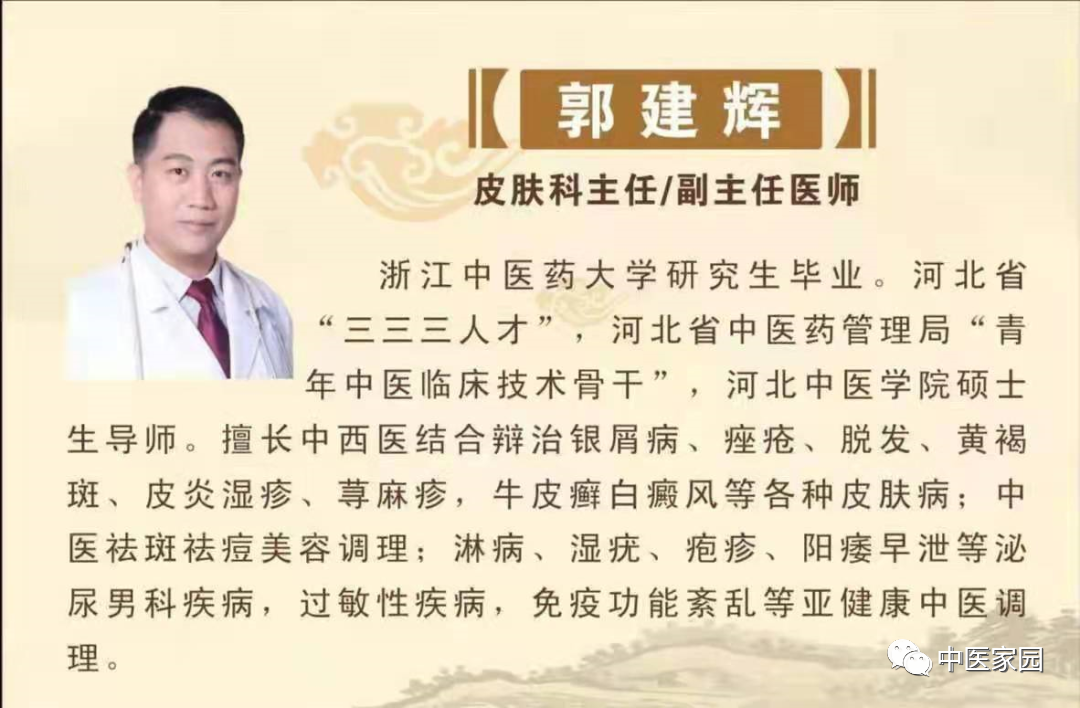
.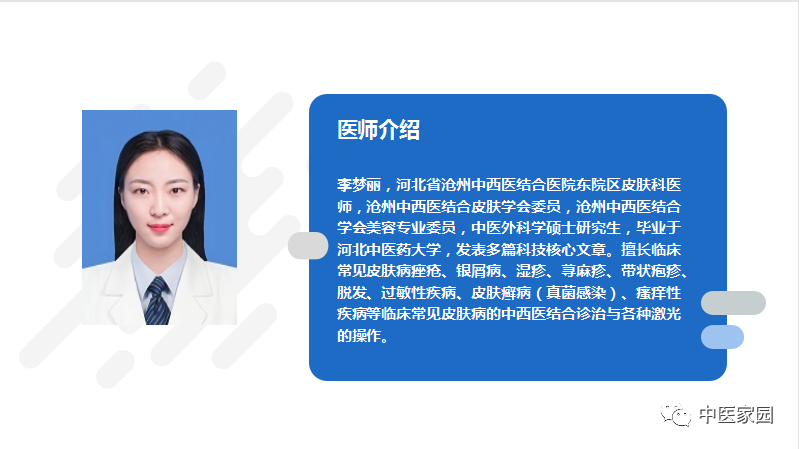
Disclaimer: Some content and text in this article are sourced from the internet. Sharing this article is for the purpose of dissemination and learning exchange. If there is any infringement, please feel free to contact us for removal.

